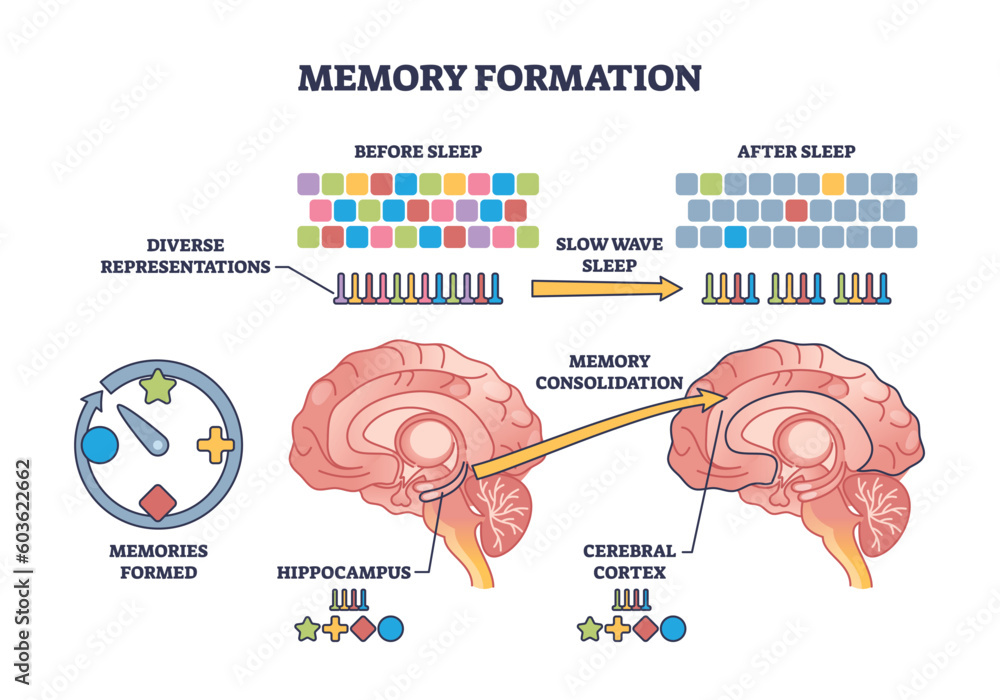Memory formation serves as a cornerstone of cognitive function, illuminating how our brains process, store, and retrieve information throughout our lives. Recent advancements in neuroscience research, particularly through innovative memory mapping techniques, have unveiled the intricate processes underlying this phenomenon. By exploring neuronal communication and the pivotal role of synaptic plasticity, scientists are uncovering not only how memories are created but also their complexities and potential dysfunctions, such as those seen in dementia. This understanding opens doors for novel dementia treatments, tailored to combat the effects of memory-related disorders. As researchers delve deeper into the molecular mechanisms of memory, we inch closer to developing effective therapies that can enhance memory resilience and cognitive robustness.
The intricate dance of cognitive processes, often referred to as memory consolidation, is fundamental to our daily experiences. A deep dive into the molecular architecture reveals the significance of synaptic connections and their behavior during learning moments. By utilizing advanced techniques for neural mapping, scholars can now observe how neural pathways adapt through synaptic modulation, a process crucial for learning retention. As we broaden our grasp of these neurological phenomena, essential insights into conditions like Alzheimer’s may emerge, driving forward therapeutic innovations and restoring cognitive vitality. Understanding these foundational elements not only enhances scientific knowledge but also fosters hope for effective interventions in memory disorders.
Understanding Memory Formation Through Advanced Techniques
Memory formation is a complex process that involves the intricate interaction of neurons within the brain’s neural networks. Recent advancements in neuroscience research, particularly the development of the Extracellular Protein Surface Labeling in Neurons (EPSILON) technique, have significantly enhanced our understanding of how memories are formed at the molecular level. By using a combination of fluorescent labeling and sophisticated microscopy, researchers can now visualize synaptic plasticity in real-time, offering unprecedented insights into the dynamics of synapses during memory formation.
This method allows scientists to observe the behavior of key proteins, such as AMPARs, which play a crucial role in synaptic strength and plasticity. Understanding these underlying mechanisms is essential not only for deciphering the processes that occur during learning but also for exploring potential therapies aimed at mitigating memory-related disorders. As research progresses, the ability to map memory formation accurately may lead to breakthroughs in dementia treatments, providing hope for individuals affected by these debilitating conditions.
The Role of Neuronal Communication in Memory Development
Neuronal communication is fundamental in the formation and retrieval of memories. At the synapse, where neurons communicate through chemical signals, the ability to adapt and strengthen these connections is essential for learning new information. This synaptic communication relies heavily on proteins like AMPARs, which have been shown to facilitate the transmission of signals between neurons. With techniques like EPSILON, researchers can delve deeper into synaptic behaviors and better understand how neuronal communication underpins the learning process.
Effective communication between neurons also ties into the larger fabric of synaptic plasticity. This plasticity allows the brain to modify its synaptic connections as experiences occur, ensuring that learning can adapt to new information. Advances in neuroscience research are helping us uncover the rules governing these changes, revealing how memories are encoded and stored in the brain. Ultimately, enhancing our comprehension of neuronal communication could lead to innovative approaches to treat disorders such as Alzheimer’s disease, which disrupts these critical processes.
Synaptic Plasticity: The Key to Adaptation and Learning
Synaptic plasticity is a defining feature of the brain’s capacity for adaptation and learning. This phenomenon describes how synapses strengthen or weaken over time in response to increases or decreases in their activity. The EPSILON technique provides a novel perspective on synaptic plasticity, allowing for the observation of these changes in a live brain context. With this increased visibility, scientists can assess how specific memories are formed and how synapses reorganize in response to new experiences.
Moreover, understanding the intricacies of synaptic plasticity enables researchers to investigate a wide range of cognitive phenomena, from simple associative learning to complex memory consolidation. Insights gained from mapping these processes may reveal critical intervention points for therapeutic strategies targeting memory impairments. As we refine our techniques for studying synaptic behavior, the potential for developing effective dementia treatments grows, paving the way for greater advancements in cognitive health.
Innovative Approaches to Dementia Treatments
The quest for effective dementia treatments has led to innovative research techniques that explore the molecular foundations of memory. The development of advanced imaging methods like EPSILON represents a significant leap forward in our capabilities to visualize and understand the synaptic dysfunctions associated with dementia. By identifying how synaptic connections deteriorate and impact memory formation, researchers can better target interventions that may halt or even reverse the progression of cognitive decline.
Current dementia treatments often focus on alleviating symptoms through pharmacological means. However, by leveraging insights from advanced neuroscience research, the potential to develop therapies that promote synaptic health and enhance plasticity offers a new dimension to treatment possibilities. As studies continue to evolve, the combination of deep molecular insights and therapeutic applications holds promise for improving outcomes for individuals living with dementia.
Integrating Basic Science with Neuroscience Research
The path from basic science to applied neuroscience applications is crucial for the development of new therapeutic strategies. Research initiatives that explore the fundamental mechanisms of brain function—such as the ones investigating synaptic plasticity—provide the foundation for future clinical applications. For instance, understanding how environmental factors and genetic predispositions influence memory can facilitate the creation of tailored therapeutic interventions.
Additionally, innovations like the HaloTag technology used in the EPSILON technique illustrate how foundational discoveries can lead to practical advancements in neuroscience research. By distributing these molecular tools globally, scientists across various fields can leverage these findings to explore the intricacies of synaptic regulation in their own research questions. This collaborative spirit in scientific research will likely yield transformative insights applicable to enhancing cognitive health and addressing memory impairments.
The Future of Memory Research and Therapy Development
As memory research continues to expand, the integration of novel techniques will play a pivotal role in shaping future therapies for cognitive disorders. The insights gained from mapping synaptic behavior and understanding memory formation will lead to a more profound grasp of how the brain changes with learning experiences. Continued exploration in this domain could result in breakthroughs that address not just the symptoms of memory disorders but their underlying causes.
Moreover, the ability to track synaptic changes over time using advanced methodologies like EPSILON will enable scientists to draw parallels between specific learning experiences and the resulting memories encoded within the brain. This could open new avenues for developing preventative strategies or interventions for individuals at risk of neurodegenerative diseases. With ongoing advancements in neuroscience research, the future is bright for the potential to enhance memory function and cognitive resilience.
Enhancing Learning through Neuroplasticity
Neuroplasticity refers to the brain’s remarkable ability to reorganize itself by forming new neural connections in response to learning and experience. Understanding the mechanisms underlying neuroplasticity is vital for developing educational strategies that enhance learning. The EPSILON technique sheds light on how synaptic strength varies with different types of learning, thus allowing researchers to devise practices that can amplify this natural capacity for adaptation in learners of all ages.
By harnessing the principles of neuroplasticity, educators can tailor learning experiences that stimulate engagement and retention. For instance, techniques that foster environments conducive to synaptic strengthening can lead to more effective educational tools. As we better understand the neurobiological foundations of learning, the potential for creating optimized educational frameworks that enhance memory formation becomes increasingly achievable.
The Impact of Synaptic Mapping on Neurological Disorders
Mapping synaptic behavior using cutting-edge techniques like EPSILON could profoundly impact our understanding of various neurological disorders beyond dementia. By accurately tracking how synapses adapt and change in response to environmental stimuli and learning experiences, researchers can identify the disruptions that contribute to cognitive impairments in conditions like schizophrenia, traumatic brain injury, and autism spectrum disorders.
Such insights allow for the development of targeted strategies to rehabilitate neural pathways and restore cognitive function. By understanding which synaptic interactions are compromised in various disorders, personalized therapeutic interventions can be designed. The integration of synaptic mapping in neuroscience research thus holds significant promise for unlocking new pathways to treat diverse neurological challenges.
Collaboration in Neuroscience for Broader Impacts
Collaboration among researchers is essential for pushing the boundaries of what we know about memory and cognitive function. The EPSILON technique has already fostered a spirit of collaboration by enabling labs around the world to access advanced molecular tools for investigating synaptic behavior. By sharing findings and insights, the scientific community accelerates the pace of discoveries that can lead to impactful treatments for memory-related disorders.
Moreover, interdisciplinary partnerships between chemists, biologists, and neuroscientists can lead to innovative approaches to studying the brain. Combining various expertise and methodologies fosters a comprehensive understanding of complex neurobiological processes. The synergy created through collaboration not only enhances the quality of research conducted but also increases the likelihood of translating discoveries into effective clinical applications for improving human health.
Frequently Asked Questions
What role does synaptic plasticity play in memory formation?
Synaptic plasticity is crucial for memory formation as it refers to the ability of synapses, the connections between neurons, to strengthen or weaken in response to experience. This process allows the brain to adapt and reorganize itself in reaction to new information, making it essential for learning and the retention of memories.
How does the memory mapping technique contribute to our understanding of memory formation?
The memory mapping technique, particularly the Extracellular Protein Surface Labeling in Neurons (EPSILON) method developed by Harvard researchers, helps visualize synaptic interactions involved in memory formation at unprecedented resolutions. By mapping proteins crucial for neuronal communication, this technique sheds light on the molecular processes governing learning and memory.
Can dementia treatments benefit from advancements in memory formation research?
Yes, advancements in memory formation research, such as the EPSILON technique that maps synaptic plasticity, are expected to lead to new insights for dementia treatments. By understanding how memory is formed and maintained at a molecular level, researchers can develop therapeutic strategies aimed at restoring synaptic function in conditions like Alzheimer’s.
What is the significance of neuronal communication in memory formation?
Neuronal communication is fundamental to memory formation as it occurs at synapses, where neurons transmit signals to one another. This interaction is facilitated by neurotransmitters and is underpinned by synaptic plasticity, which enables changes in synapse strength, essential for learning new information and forming lasting memories.
How does the EPSILON technique enhance our understanding of synaptic plasticity and memory?
The EPSILON technique enhances our understanding of synaptic plasticity and memory by allowing researchers to monitor the dynamics of synaptic proteins, such as AMPARs, in real time. This high-resolution observation provides insights into how memories are stored by revealing the patterns of synaptic strengthening and weakening that occur during learning processes.
What implications does neuroscience research on memory formation have for cognitive therapies?
Neuroscience research on memory formation has significant implications for cognitive therapies. Understanding the molecular underpinnings of memory, such as through studies using the EPSILON technique, can inform the development of therapies that target specific synaptic processes, potentially improving cognitive functions in individuals with memory impairments.
How does AMPAR trafficking relate to memory formation?
AMPAR trafficking refers to the movement of AMPA receptors, which play a crucial role in synaptic plasticity, to and from the synapse. This trafficking is closely linked to the formation of enduring memory traces, known as engrams, which are established when specific neurons become activated during learning experiences.
| Key Point | Details |
|---|---|
| Research Team | Harvard researchers led by Adam Cohen, including lab members and scientists from Howard Hughes Medical Institute. |
| New Technique | Extracellular Protein Surface Labeling in Neurons (EPSILON) to map proteins essential for synaptic plasticity and memory formation. |
| Significance | Provides insights for developing therapies for neurological disorders, including dementia and Alzheimer’s disease. |
| Mechanism | EPSILON allows monitoring of AMPARs involved in synaptic strength and retrieval of memories. |
| Methodology | Combines fluorescent labeling and advanced microscopy for high-resolution observations of synaptic interactions. |
| Future Applications | Potential to study various cognitive functions and improve interventions for memory impairments. |
Summary
Memory formation is the intricate process by which our brains encode, store, and retrieve information, and groundbreaking research at Harvard has unveiled a novel technique that illuminates this complexity. By utilizing the EPSILON method, scientists can map the synaptic changes that occur during memory formation, paving the way for more effective treatments for disorders like dementia. The insights gained from this research not only deepen our understanding of how memories are structured within the neural architecture but also hold promise for transformative therapies targeting cognitive deficits. As we continue to explore the molecular underpinnings of memory formation, the potential for advancements in mental health care grows exponentially.









